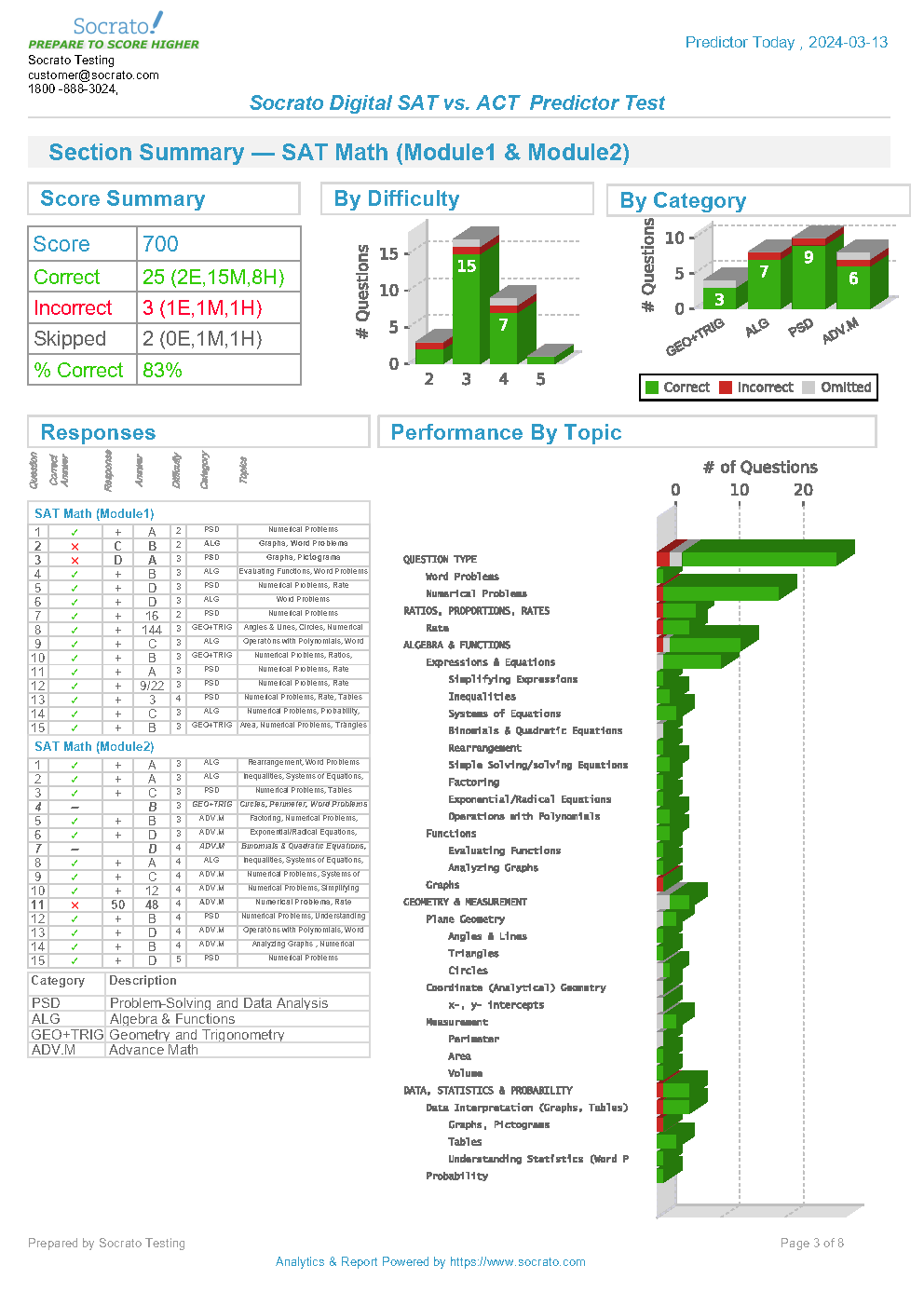Digital SAT vs. Enhanced ACT Predictor Test Details & What You’ll Get
Introduction: Deciding whether to take the Digital SAT or Enhanced ACT can determine your college admission success. Moreover, our comprehensive 161-minute Digital SAT vs. Enhanced ACT predictor test analyzes your performance on both exam formats to identify which standardized test maximizes your college admission potential. As a result, you’ll get instant results with an 8-page personalized report comparing Digital SAT vs. Enhanced ACT scores.
Test Format & Structure
We’ve designed the predictor to mirror real test conditions. The total Test time is 2 hours and 41 minutes. Here’s the breakdown of all the sections.
| Table 1: Test Structure and Details | |||||
|---|---|---|---|---|---|
| Test | Section | Calculator | Questions (?) | Timing ⏱ (minutes) | Time/Question ⏳ (seconds) |
| ACT | English 📝 | N/A | 25 | 18 | 43.2 |
| SAT | Math ➗ | ✔ Yes | 20 | 23 | 69 |
| SAT | Reading/Writing 📖 | N/A | 45 | 54 | 72 |
| ACT | Math ➗ | ✘ No | 20 | 23 | 69 |
| ACT | Reading 📚 | ✘ No | 20 | 23 | 69 |
| ACT | Science 🔬 | ✘ No | 20 | 20 | 60 |
| TOTAL | 150 | 161 | 382.2 | ||
What’s Included in the Digital SAT vs. Enhanced ACT Diagnostic Report
After completing the test, you’ll receive a comprehensive diagnostic report. Here’s what we include:
- Section-by-section performance metrics for both the Digital SAT and Enhanced ACT.
- Comparison of your strengths and weaknesses: which test format suits you more?
- Question‐difficulty breakdown per section.
- Topic analysis: which subtopics (e.g. grammar, algebra, science) need more work?
- Percentile predictions & overall test recommendation (Digital SAT, Enhanced ACT, or both).
- Instant online access to results + downloadable diagnostic report PDFs.

Figure 1: Digital SAT Math (Module 1 & 2)

Figure 2: Enhanced ACT Reading
Why This Diagnostic Helps You Choose Wisely
- Save time and energy by focusing your preparation on the test you’re more likely to excel in.
- Understand pacing and question type differences, so you’re not surprised on test day.
- Tailor your study plan with data-driven insights rather than guesswork.
- Saves time by taking one test instead of 2 separate tests.
Why to Take the Digital SAT vs. Enhanced ACT Predictor?
Save Time and Energy
Focus your preparation on the test you’re most likely to excel on to maximize your study efficiency.
Understand Pacing and Question Type
Get familiar with different formats so you’re not surprised on test day and can manage your time effectively.
Tailor Your Study Plan
Receive data-driven insights instead of guessing to create a personalized preparation strategy.
Saves Time
Take one comprehensive test instead of 2 separate tests to streamline your decision-making process.
How to Take the Digital SAT vs. Enhanced ACT Predictor Test?
Sign Up & Create Account
Create your Socrato account to get started.
Choose Format
Digital or Paper Scan testing option.
Complete Test
Set aside uninterrupted time for all sections.
Get Results
Get a detailed diagnostic report immediately.
- Sign up and create the Socrato account.
- Choose a testing option: digital or paper scan.
- Set aside uninterrupted time to complete all sections.
- Submit the test results.
- Get your detailed diagnostic report immediately.
Start Your Digital SAT vs. Enhanced ACT Diagnostic
Don’t guess which test you should take. Start your diagnostic now to identify which test maximizes your score potential.
Frequently Asked Questions
Get answers to common questions about our diagnostic test.
- Predicted SAT and ACT scores.
- Strengths and weaknesses by subject and topic.
- Question-type analysis.
- Recommendation on which test the student is likely to perform better on.
- For online: a device with a stable internet connection.
- For paper: printed test booklet, bubble sheet, #2 pencil, and calculator.
